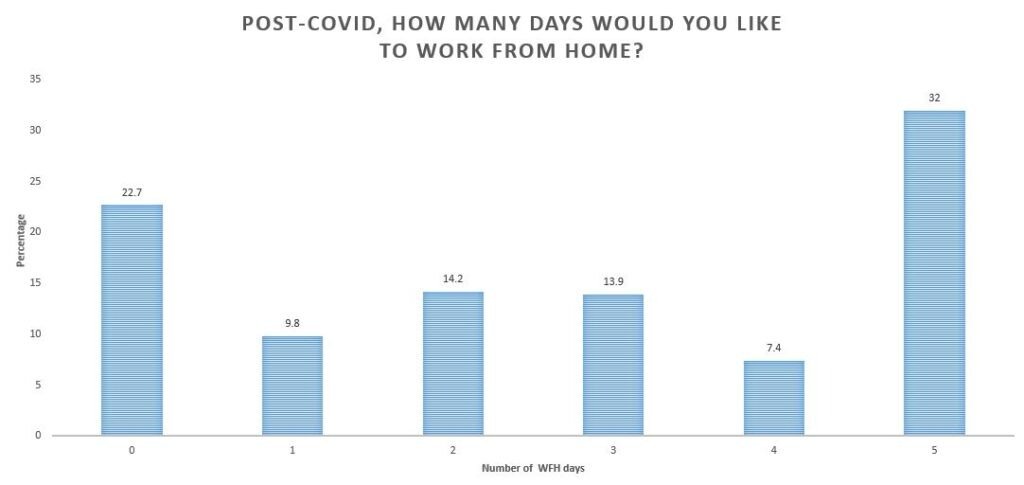Working from home is simply a fad

This article was originally posted on the LTI blog
As the world gradually shifts toward post-pandemic work-life, companies are currently searching for new solutions and best practices.
While some organizations have a strong propensity toward a full 5-days-a-week return to the office (RTO), others offer partial or even full work from home (WFH) options. In recent months I have met and worked with hundreds of managers across different industries and geographies. Through their experiences and difficulties, I came to realize that there are four common misconceptions today that leaders need to be aware of when it comes to defining the “new normal.”
In this article, I outline these four misconceptions and suggest five steps to move forwards toward an optimal post-pandemic worklife.
Misconception 1: Working from home is simply a fad
In Feb 2021, David Solomon, CEO of Goldman Sachs, stated that working from home is “not a new normal. It’s an aberration that we’re going to correct as soon as possible” [1].
This statement reminded me of another wise investment banker who refused to invest in Henry Ford’s Model T back in 1903, claiming that “The horse is here to stay, but the automobile is only a novelty, a fad” [2].
But Solomon is not the only industry leader who believes working from home (WFH) is a temporary solution to be soon rectified. James Gorman, chairman and CEO of investment giant Morgan Stanley warned his employees back in June 2021 to be back at work by Labour day or “we’ll have a different kind of conversation”[3]. Although Gorman has retracted his statement saying he was wrong to push for a full return to the office [4], many managers still share this sentiment.
In fact, post-Covid survey data suggests that 34% of all knowledge workers have already reverted to working five days a week from the office. However, after previously experiencing remote or hybrid, these employees report a 2x decline in work-life balance and a 1.6x decline in their overall job satisfaction compared to employees who experience more work flexibility.
Worst yet, these employees encounter a 1.5x increase in stress and anxiety compared to their more flexible counterparts [5].
So, is WFH simply a fad?
So far, multiple studies and survey data clearly confirm it is not.
A recent global survey commissioned by Google demonstrates how the concept of hybrid work is already deeply rooted in the way we think about the future of work. Although 70% of the survey’s respondents never worked remotely prior to the pandemic, 75% of the participants believe hybrid/flexible work will be standard practice in the upcoming years[6]. Furthermore, researchers have recently found that remote work opportunities for high-paying jobs are rapidly increasing from roughly 4% pre-pandemic to 15% by the end of 2021 [7] and 25% in 2022 [8].
While some organizations consider flexible work as mere perks or temporary fixes to the current pandemic problem, most employees perceive this newfound flexibility as a fundamental workplace requirement.
In fact, 64% of the employees say they prefer permanent work from home over a 30,000 USD raise [9], and 42% of the current remote workers prefer quitting their job if their employer will not allow hybrid work in the future [10].
Misconception 2: We know what our employees want
Although most leaders believe they know exactly what their employees want, studies have repeatedly shown a growing disconnect between employees and leaders as the world goes through an accelerated period of transformation.
While employees’ drivers, needs, and aspirations shifted considerably during the pandemic, leaders are still working under outdated assumptions and need an urgent wake-up call [11].
I refer to this disconnect as The Post pandemic workplace Divide (or simply The Divide for short).
The Divide is the reason why in a recent survey of over 14,000 participants across 13 countries, 87% of the employees felt that their company is not attentive enough to their needs, and 85% felt unsatisfied with how their employers support them [12].
Additionally, one study found that 68% of leaders feel they created an empowering, innovative, and safe workplace environment during the pandemic, yet, only 36% of the employees agree, and 76% of leaders say their employees currently have a choice on when, where and how to work, yet only 29% of employees concur with that statement [13].
Misconception 3: We need a temporary quick-fix hybrid solution
As there are still no best practices for working from home (especially for larger-scale companies), many companies opted to create a temporary yet rigid hybrid work policy. Apple has recently rolled out its RTO policy. Starting May 23rd, employees are required to be in the office on Mondays, Tuesdays, and Thursdays. Google followed a similar course of action by requesting employees to return to their office on Tuesdays, Wednesdays, and Thursdays (realizing that employees’ favorite days for WFH are Mondays and Fridays [8]).
Although some Google leaders claim this change is temporary until a more coherent solution is found, its recent announcement of a $9.5bn investment in offices and data centers this year sends a very different message [14].
Since rolling out the new RTO policies, these companies have experienced significant push-back initiatives [See, for example, here 14,15,18, to name but a few].
Apple CEO Tim Cook received an open employee letter formally requesting Apple to reconsider its RTO policies [16], and the social network Blind reported that in a recent survey two-thirds of Googlers were dissatisfied with the RTO policy, and 34%(!) stated they would look for another job due to Google’s plan to return to office [17].
These new tone-deaf RTO policies may have broader implications for leaders in Apple, Google, and other similar companies.
Data indicates that employees who are not satisfied with their work flexibility are three times more likely to look for a new job in the coming year than their more satisfied counterparts[19].
Moreover, knowledge workers who say they have little to no control over their work flexibility report experiencing 1.7x worse work-life balance, 2.2x worse work-related stress and anxiety, and 1.4x worse burnout [19].
While rolling out a non-flexible RTO policy may seem like the simplest solution, managers need to consider whether, in the long run, this is the best course of action for their most valuable knowledge workers during this period of The Great Resignation.
Misconception 4: We should let every employee decide for themselves
While most employees benefit from flexible work, many also crave more in-person work and collaboration, especially after the pandemic [20]. This apparent inner conflict between more flexibility and more connection is what Microsoft CEO, Satya Nadella, refers to as the “Hybrid work paradox” [21].
Not surprisingly, the issue of employee choice vs. team coordination is tricky as employees want to enjoy both worlds.
When asked how many days per week they would like to work from home, employees show a considerable variation (see Figure1), and two recent surveys found conflicting results where 69.9% of the employees preferred to choose their own WFH days, and 75.6% prefer to coordinate workday with their coworkers [8].

Figure 1: How many days would employees like to work from home? [24]
The problem becomes even more convoluted when we factor in the employee’s age, family situation, position, gender, personal preferences, and even race.
While younger generations lack more office time for onboarding and mentoring, young parents (especially moms) need more flexibility and work-life balance. Recent data shows that an all-time high of 82% of working moms want more work flexibility. Minorities also show a greater desire for flexibility (especially women of color), and gender-wise, women have shown a higher preference for WFH three to five days a week (58%) as compared to men (48%) [19].
Work equality concerns are also on the rise due to hybrid work. As more companies push towards a return to the office, the assumption is that managers will work in the office more often than their employees. This means that those employees physically in the office will usually gain better work visibility [22]. They will also have better and quicker access to technical and emotional support, and will have the advantage of getting faster and more accurate information, some of it through informal water-cooler discussions. This leads to a heightened concern of inequality for parents. For example, 46% of parents believe that remote work will have a negative effect on their career progression (as compared to 34% for non-parents) [19]
Other issues that come into play when opting for flexible employee choices are the team’s best interest, client and project needs, organizational culture, and peer and managerial pressure to work from the office.
Finding the optimal solution for your team
As leaders continue to search for the optimal solution, here are five steps I often advise leaders I work with to use:
1. Take the first step
“Take the first step in faith. You don’t have to see the whole staircase, just take the first step” – Martin Luther King Jr.
Finding the optimal solution for your teams means entering into largely uncharted waters. There are no tried-and-test best practice solutions, at least not yet. Getting trapped in the past will not help your team move forward. Therefore, leaders need to be open and attentive to the diverse needs of the teams, the projects, and the clients (more on this later).
2. Make an effort to truly listen
Each team member has different needs. Attentively listening and understanding the employees’ needs is the best way to both find the optimal solution and let your team know you care. In larger companies, we often start by running an organization-wide survey (I will soon add a post about asking the right survey questions). In smaller teams, we usually conduct interviews with all or key members.
3. Facilitate open discussions
Openly communicating our needs in the team allows for a higher level of mutual understanding. We often lead with a 1-2-4-All [23] facilitation technique in larger groups or open group conversations to create multiple semi-structured discussions.
4. Use the 3-lens Framework
The World Trend Index of 2022 states that although many employees say that their biggest challenge is “knowing when and why to come into the office” when it comes to hybrid work, most companies have not established clear agreements and effective norms [20].
While defining new norms is the first step, it is also important to realize that today’s organizations are trapped in a single-dimensional conversation over the number of days and hours in and out of the office. However, research on remote work dating back to the ’60s as well as current surveys show that, in actuality, we need to hold three separate and often conflicting discussions holding three different lenses: the Project lens, the People lens, and the Culture lens.
The 3-lens Framework is a simple yet powerful process for co-creating a new hybrid worklife environment through a series of semi-structured team-wide conversations. The framework supports both leaders and teams in designing their optimal hybrid worklife.
I recently wrote an article specifically on getting alignment using this framework here.
5. Avoid the “Not Invented Here” syndrome
The “Not Invented Here” syndrome is the tendency of social groups to reject and avoid using any solution from external origins.
Leaders often make the mistake of first spending a long time strategizing, either on their own or with top management, only later to fail to generate long-term buy-in from their teams.
Co-creating an optimal worklife strategy with and for the team negates the need to later “sell” the idea to the same employees. This strategy creates deeper, long-lasting buy-ins and avoids the “Not Invented Here” syndrome entirely.
Conclusion and a few final words
Showing care and flexibility while allowing employees to co-create the optimal worklife environment for them and their teams has never been as crucial for employee engagement and wellbeing as they are today.
As the workplace transitions into a post-pandemic new normal, leaders and companies who would like to stay ahead of the curve need to create those optimal worklife environments now to both retain as well as attract the best talent.
Resources:
[1] CNBC, 2021:“Goldman Sachs CEO Solomon calls working from home an ‘aberration’”
[2] Quote Investigator
[3] NBC news, 2021: “’Be back by Labor Day’ — Morgan Stanley CEO issues sternest warning yet for employees delaying a return to work”
[4] CNBC, 2021: “Morgan Stanley CEO says he was wrong on return-to-office push”
[5] Future Forum, 2022: Win the battle for talent,
[6] Google Workspace, 2022: Insights from our global hybrid work survey
[7] The Ladders, Oct 2021
[8] Barrero, J. M., Bloom, N., & Davis, S. J. (2021). Why working from home will stick (No. w28731). National Bureau of Economic Research
[9] Bizjournal, 2021: Work from home or a $30K raise? Employees said it wasn’t even close
[10] Prudential, 2021: Increasingly, workers expect pandemic workplace adaptations to stick
[11] Microsoft, 2021: The Work Trend Index
[12] Oracle, 2021: Global Study
[13] Accenture, 2020: Getting to Equal 2020 Research Report
[14] Linkedin, 2022: “Google’s big bet on RTO”
[15] Protocol, 2022: “Google employees say its return-to-office plan is unfair”
[16] The Verge, 2021: “Apple employees push back against returning to the office in internal letter”
[17] HRD, 2022: “Google’s hybrid work policy isn’t popular amongst employees”
[18] Furtune, 2022: “Frustrated Apple employees reject CEO Tim Cook’s hybrid plan by threatening to quit”
[19] Pulse, 2022: “Inflexible return-to-office policies are hammering employee experience scores”
[20] Microsoft, 2022: The Work Trend Index
[21] Linkedin, 2021: The hybrid work paradox
[22] O’Connor, L. T., & Cech, E. (2018). Your Flex Work Culture Doesn’t Help Employees If It Hurts Their Careers. Harvard Business Review.
[23] Liberating Structures, 1-2-4-All
[24] Figure data from https://wfhresearch.com/, 2022





